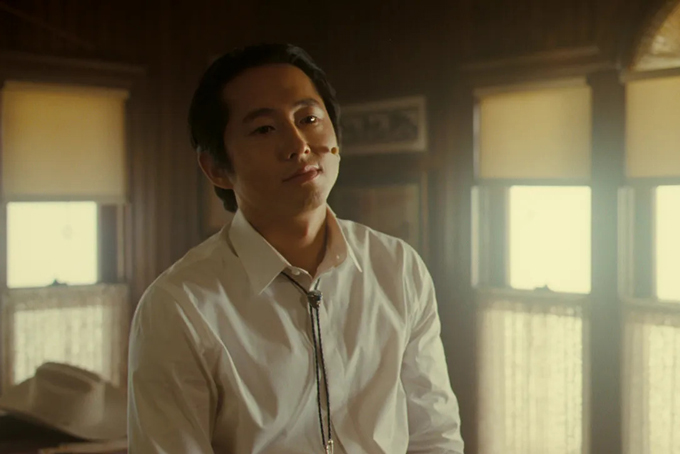The outfits in Nope, Jordan Peele’s latest film, tell their own complex and metaphor-filled story. This makes sense for a film that operates heavily through symbols and references—telling the mind-bending story of an alien organism that buckles against being seen or photographed. Another major plot point of the modern Western involves the Haywood siblings, played by Daniel Kaluuya and Keke Palmer, fighting to retain ownership of their horse ranch, kept afloat through Hollywood gigs. (Note: spoilers ahead). The film’s costume designer, Alex Bovaird, added poetic layers to Peele’s visual masterpiece through her lauded and in-demand touch. (Past credits of hers include The White Lotus, American Honey and Bad Education.)
Bovaird points to the instantly recognisable red cowboy suit worn by Steven Yeun’s fame-hungry character, Jupe, during a pivotal, and gruesome, scene. The razzle-dazzle suit, which features flamboyant embroidery and fringed sleeves, is a direct nod to Elvis Presley. Bovaird says Jupe and Elvis are both “examples of what stardom does to people and being an attention-junkie. Elvis was probably the first victim of fame, so there was a little recall of him there.” The biggest twist: the suit almost didn’t make the film. In an alternate world, Jupe wore a standard, run-of-the-mill hoodie while getting a little too close to the otherworldly.
Bovaird delivers nuggets of insight like these casually while talking to Vogue from Alaska, where she is currently prepping for her next project, season four of True Detective, which will star Jodie Foster. Bovaird says she employs “a method approach” to dressing characters. “I really get under their skin and try to figure out how they think,” she says. “I ask questions like, ‘What colour suits them?’, ‘Can they even dress themselves?’, ‘Are they trying hard?’” In many ways, her job is to channel the varied and complex factors behind how and why we dress the way we do each day.
Below, Bovaird breaks down the costume design of Nope, touching on the influence of The Goonies, obscure rock bands and ’90s sitcoms along the way.

Let’s start with Angel’s wardrobe. He’s kind of an enigmatic figure in the film because he is not part of the Haywood family and he joins the action in this roundabout way. We don’t learn much about him other than that he works at an electronics store and distrusts the government. What does his wardrobe reveal about him?
We came up with the idea that he’s a bit of a cynical, angry guy. So we tried to find some obscure bands that he might be into. He wears a T-shirt by a band called Earth, and they’re this doom metal group. We also wanted a dark palette for him, because [Brandon Perea] is naturally very effervescent. He shows up looking like a roadie sometimes. He’s got cut-offs, band tees, Vans. He’s a California Latin guy—so we tried to imagine him as “Latin emo.” But even then he was still perky. So we had to bring him into more punk band territory.
How did the California setting influence the fashion in the film?
We tried to make the whole thing a bit enhanced in terms of colour and fun. We had this idea of making outfits that were punchy. I remember watching the trailer and thinking, “Wow, they look like crayons!” But it was on purpose. We thought the contrast of these super neon colours against the desert backdrop would be really cool. I remember seeing David LaChapelle stuff in the ’90s and being really captivated by it. These really bright, colourful figures against the California landscape.






